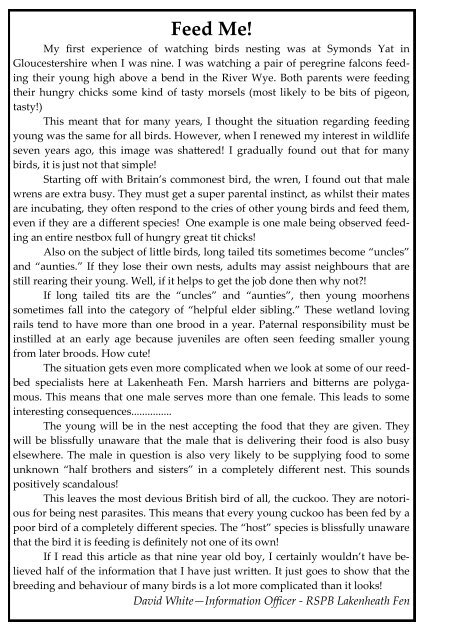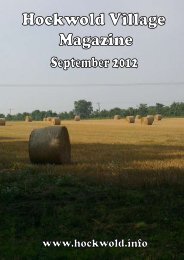parish council - Hockwold-cum-Wilton
parish council - Hockwold-cum-Wilton
parish council - Hockwold-cum-Wilton
You also want an ePaper? Increase the reach of your titles
YUMPU automatically turns print PDFs into web optimized ePapers that Google loves.
Feed Me!<br />
My first experience of watching birds nesting was at Symonds Yat in<br />
Gloucestershire when I was nine. I was watching a pair of peregrine falcons feeding<br />
their young high above a bend in the River Wye. Both parents were feeding<br />
their hungry chicks some kind of tasty morsels (most likely to be bits of pigeon,<br />
tasty!)<br />
This meant that for many years, I thought the situation regarding feeding<br />
young was the same for all birds. However, when I renewed my interest in wildlife<br />
seven years ago, this image was shattered! I gradually found out that for many<br />
birds, it is just not that simple!<br />
Starting off with Britain’s commonest bird, the wren, I found out that male<br />
wrens are extra busy. They must get a super parental instinct, as whilst their mates<br />
are incubating, they often respond to the cries of other young birds and feed them,<br />
even if they are a different species! One example is one male being observed feeding<br />
an entire nestbox full of hungry great tit chicks!<br />
Also on the subject of little birds, long tailed tits sometimes become “uncles”<br />
and “aunties.” If they lose their own nests, adults may assist neighbours that are<br />
still rearing their young. Well, if it helps to get the job done then why not?!<br />
If long tailed tits are the “uncles” and “aunties”, then young moorhens<br />
sometimes fall into the category of “helpful elder sibling.” These wetland loving<br />
rails tend to have more than one brood in a year. Paternal responsibility must be<br />
instilled at an early age because juveniles are often seen feeding smaller young<br />
from later broods. How cute!<br />
The situation gets even more complicated when we look at some of our reedbed<br />
specialists here at Lakenheath Fen. Marsh harriers and bitterns are polygamous.<br />
This means that one male serves more than one female. This leads to some<br />
interesting consequences...............<br />
The young will be in the nest accepting the food that they are given. They<br />
will be blissfully unaware that the male that is delivering their food is also busy<br />
elsewhere. The male in question is also very likely to be supplying food to some<br />
unknown “half brothers and sisters” in a completely different nest. This sounds<br />
positively scandalous!<br />
This leaves the most devious British bird of all, the cuckoo. They are notorious<br />
for being nest parasites. This means that every young cuckoo has been fed by a<br />
poor bird of a completely different species. The “host” species is blissfully unaware<br />
that the bird it is feeding is definitely not one of its own!<br />
If I read this article as that nine year old boy, I certainly wouldn’t have believed<br />
half of the information that I have just written. It just goes to show that the<br />
breeding and behaviour of many birds is a lot more complicated than it looks!<br />
David White—Information Officer - RSPB Lakenheath Fen



